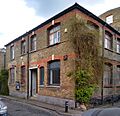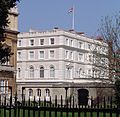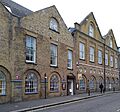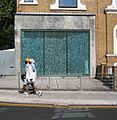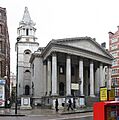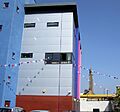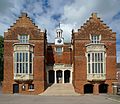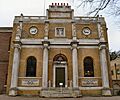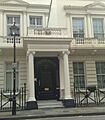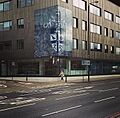List of museums in London facts for kids
London, the capital city of England, is home to many incredible museums. These places are perfect for exploring history, art, science, and all sorts of fascinating topics. Imagine stepping back in time, seeing amazing artworks, or discovering how things work! As of 2016, there were over 250 registered art and history places in London. This guide will tell you about some of the most exciting museums you can visit.
Contents
- Top Museums in London
- Explore History and Culture
- British Museum: A World of Wonders
- Museum of London: The City's Story
- Tower of London: A Royal Fortress
- Churchill War Rooms: Secret History
- Imperial War Museum London: Stories of Conflict
- Museum of London Docklands: River Life
- Ragged School Museum: Victorian School Days
- Jewish Museum London: A Rich Heritage
- Queer Britain: Celebrating LGBTQ+ History
- Amazing Art and Design Museums
- Victoria and Albert Museum: Art and Design for Everyone
- Tate Modern: Modern Art Masterpieces
- Tate Britain: British Art Through Time
- National Gallery: Famous Paintings
- National Portrait Gallery: Faces of History
- Design Museum: Everyday Objects, Amazing Stories
- William Morris Gallery: Arts and Crafts Beauty
- Science, Nature, and Technology
- Unique and Fun Museums
- Explore History and Culture
- Popular Museums by Visitors
- Images for kids
Top Museums in London
London has a huge variety of museums, from ancient history to modern art. Here are some of the most popular and interesting ones for young explorers.
Explore History and Culture
British Museum: A World of Wonders
The British Museum is one of the oldest and largest museums in the world. It's in the Bloomsbury area and is full of treasures from all over the globe. You can see ancient Egyptian mummies, incredible Roman sculptures, and artifacts from Greece, the Middle East, Africa, and Asia. It's like taking a trip around the world without leaving London!
Museum of London: The City's Story
Want to know how London became the amazing city it is today? The Museum of London tells the story of London from prehistoric times to the present. You can see what Roman London looked like, explore medieval streets, and learn about the Great Fire of London. It's a fantastic way to understand the city's past.
Tower of London: A Royal Fortress
The Tower of London is a famous historic castle and former royal palace. It has been a fortress, a prison, and even a zoo! You can see the sparkling Crown Jewels, learn about famous prisoners, and meet the Beefeaters (the Yeoman Warders who guard the Tower). Don't forget to look for the ravens – legend says if they leave, the Tower will fall!
Churchill War Rooms: Secret History
Step into a secret underground bunker where Winston Churchill and his team directed Britain's efforts during World War II. The Churchill War Rooms are preserved just as they were during the war. You can explore the Cabinet War Rooms and visit the museum dedicated to Churchill's life. It's a real-life spy adventure!
Imperial War Museum London: Stories of Conflict
The Imperial War Museum London tells the stories of people's experiences during wars in the 20th and 21st centuries. It helps us understand the impact of conflict on individuals and society. You can see real tanks, planes, and learn about the bravery of ordinary people.
Museum of London Docklands: River Life
Located in the historic Isle of Dogs, the Museum of London Docklands explores the history of London's river, port, and people. You can learn about trade, sailors, and the lives of those who worked on the docks. It's a fascinating look at how the River Thames shaped London.
Ragged School Museum: Victorian School Days
The Ragged School Museum offers a glimpse into what school was like for poor children in Victorian times. You can sit in a real Victorian classroom and imagine life without computers or fancy textbooks. It's a great way to appreciate how much education has changed!
Jewish Museum London: A Rich Heritage
The Jewish Museum London celebrates Jewish culture, heritage, and traditions in Britain. It has beautiful ceremonial art and tells the stories of Jewish people in London through history.
Queer Britain: Celebrating LGBTQ+ History
Queer Britain is the UK's first museum dedicated to LGBTQ+ (Lesbian, Gay, Bisexual, Transgender, Queer, and others) history and culture. It shares important stories and celebrates the lives of LGBTQ+ people in Britain.
Amazing Art and Design Museums
Victoria and Albert Museum: Art and Design for Everyone
The Victoria and Albert Museum (V&A) is a huge museum dedicated to art, design, and performance. You can see everything from ancient sculptures to modern fashion, jewelry, and furniture. It's a fantastic place to get inspired by creativity from around the world.
Tate Modern: Modern Art Masterpieces
Located in a former power station on the Bankside of the River Thames, Tate Modern is Britain's national museum of modern and contemporary art. You'll find exciting and sometimes surprising artworks from the 20th and 21st centuries.
Tate Britain: British Art Through Time
Tate Britain is home to the national collection of British art, from the 16th century to today. You can see famous paintings by artists like J.M.W. Turner and explore how British art has changed over hundreds of years.
National Gallery: Famous Paintings
The National Gallery in Trafalgar Square houses a collection of Western European paintings from the 13th century to 1900. You can see masterpieces by artists like Van Gogh, Leonardo da Vinci, and Monet. It's a must-see for art lovers!
National Portrait Gallery: Faces of History
Right next to the National Gallery, the National Portrait Gallery displays portraits of famous and important British people throughout history. It's a fun way to see the faces behind the stories you've learned.
Design Museum: Everyday Objects, Amazing Stories
The Design Museum explores the world of product, industrial, graphic, fashion, and architectural design. It shows how everyday objects are created and how design influences our lives. You'll never look at a chair or a phone the same way again!
William Morris Gallery: Arts and Crafts Beauty
The William Morris Gallery is dedicated to the life and work of the famous designer, writer, and artist William Morris. It showcases beautiful furniture, textiles, ceramics, and glass from the Arts and Crafts movement.
Science, Nature, and Technology
Natural History Museum: Dinosaurs and More!
The Natural History Museum is famous for its incredible dinosaur skeletons, including the huge T-Rex. But it's also home to millions of specimens from the natural world, covering botany, entomology (insects), mineralogy, paleontology (fossils), and zoology. It's a fantastic place to learn about our planet and its creatures.
Science Museum: Discover and Invent
The Science Museum is a national museum of science and technology. You can explore amazing exhibits on space, transport, medicine, and steam engines. It's a hands-on museum where you can discover how things work and learn about incredible inventions.
London Transport Museum: Journey Through Time
The London Transport Museum in Covent Garden tells the story of public transport in London. You can see old buses, trains, and learn about the history of the Underground (the Tube). It's a fun ride through London's travel history!
Royal Observatory, Greenwich: Time and Stars
Part of the National Maritime Museum, the Royal Observatory, Greenwich is where Greenwich Mean Time (GMT) was established. You can stand on the Prime Meridian, explore astronomical tools, and visit the planetarium to learn about stars and space.
Cutty Sark Museum: A Fast Ship's Tale
The Cutty Sark Museum is a real 19th-century clipper ship, one of the fastest of its time. You can explore the ship, learn about its voyages, and imagine life as a sailor on the high seas.
London Museum of Water & Steam: Power of Water
This museum in Brentford celebrates the history of London's water supply and has a collection of huge steam engines that used to pump water. It's a great place to see impressive Victorian engineering in action.
Unique and Fun Museums
Young V&A: Play and Learn
Formerly known as the V&A Museum of Childhood, the Young V&A in Bethnal Green is all about toys, dolls, and children's playtime. It's a wonderful place to explore how children have played and lived throughout history.
Horniman Museum and Gardens: Global Collections
The Horniman Museum and Gardens in Forest Hill has a diverse collection of musical instruments, natural history specimens, and artifacts from different cultures around the world. It also has beautiful gardens and an aquarium!
Sherlock Holmes Museum: A Fictional Detective's Home
If you love mysteries, you might enjoy the Sherlock Holmes Museum at 221B Baker Street. It's dedicated to the famous fictional detective Sherlock Holmes and his adventures.
Fan Museum: Art of the Fan
The Fan Museum in Greenwich is a unique place dedicated to the art and craft of the fan. You can see beautiful and historic fans from different cultures and time periods.
Musical Museum: Automated Instruments
The Musical Museum in Brentford has an amazing collection of self-playing musical instruments, from music boxes to huge automatic organs. It's a treat for your ears!
Pollock's Toy Museum: Old-Fashioned Fun
Pollock's Toy Museum is a charming, old-fashioned museum filled with toys, games, dolls, and puppets from different eras. It's a nostalgic trip back to childhood.
Popular Museums by Visitors
Many of London's museums are free to enter, which means lots of people can enjoy them! Here are some of the most visited museums in London, based on figures from the financial year ending March 31, 2008:
- Tate Modern and Tate Britain – over 6.7 million visitors (combined)
- British Museum – over 6 million visitors
- National Gallery – over 3.9 million visitors
- Natural History Museum – over 3.6 million visitors
- Science Museum – over 2.7 million visitors
- Victoria and Albert Museum – over 2.2 million visitors
- National Maritime Museum – over 1.7 million visitors
- National Portrait Gallery – over 1.6 million visitors
- Imperial War Museum – over 759,000 visitors
- Horniman Museum – over 477,000 visitors
Since 2001, most government-funded museums in the UK have offered free admission. This has helped many more people visit and enjoy these wonderful places.
Images for kids






































